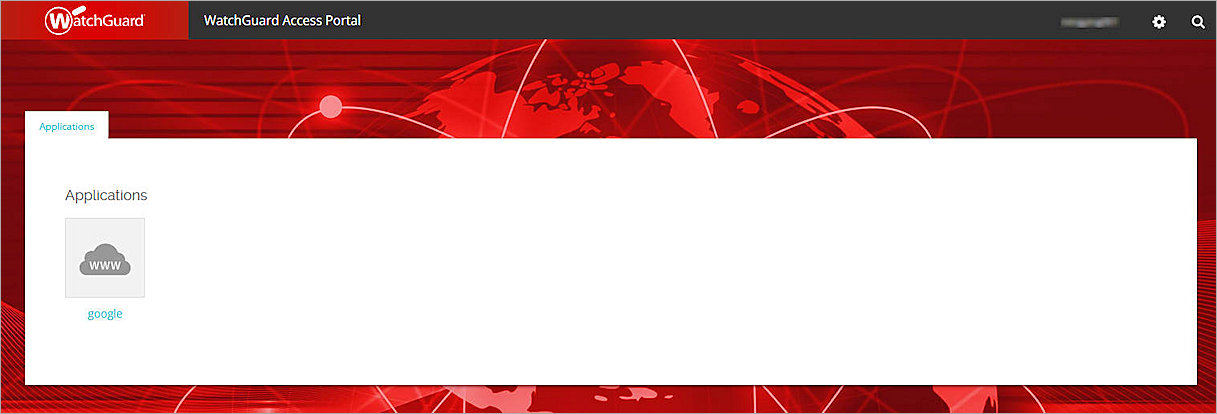This document describes how to set up multi-factor authentication (MFA) for your Firebox Access Portal with AuthPoint as an identity provider. Access Portal must already be configured and deployed before you set up MFA with AuthPoint.
Firebox Access Portal can be configured to support MFA in several modes. For this integration, we set up SAML with AuthPoint.
This integration guide describes two configurations for Access Portal SAML authentication based on the different versions of Fireware. We recommend that you upgrade to the Fireware v12.11 or higher.
Contents
Firebox Access Portal Authentication Data Flow with AuthPoint
AuthPoint communicates with various cloud-based services and service providers with the SAML protocol. This diagram shows the data flow of an MFA transaction for a Firebox Access Portal.

Access Portal Certificate Expiration
When you configure the Access Portal, the Firebox generates an Access Portal certificate that you download from the Configuration Instructions Page. You upload this certificate to AuthPoint when you create a SAML resource for the Access Portal.
The Access Portal certificate you download is valid for one year from the date you select the Enable SAML check box in Fireware. After you install the certificate, you can view the certificate expiry date in Fireware Web UI.
When an Access Portal certificate expires, a new certificate is generated automatically, and the Firebox generates an event log message with Message ID 7600-0000. In Fireware System Manager, you can enable notifications for events with Message ID 4001-0004 when a certificate expires. For more information, go to Enable Notifications for Specific Messages.
After the Firebox generate a new Access Portal certificate, you must upload the new certificate to your SAML resource in AuthPoint. For more details about how to update this certificate, go to Configure AuthPoint.
Before You Begin
Before you begin these procedures, make sure that:
- You have applications configured in your access portal
- Firebox with Fireware v12.11 or higher
- Firebox with Fireware v12.10 or lower
- Feature key with an Access Portal license
- A token is assigned to a user in AuthPoint
- You have an AuthPoint identity provider (IdP) certificate (go to Certificate Management)
Configure Firebox Access Portal
The steps to configure MFA for the Access Portal depend on which version of Fireware you use. Follow the steps in the relevant section below.
Enable Access Portal
- Log in to Fireware Web UI (https://<your Firebox IP address>:8080).
- Select Subscription Services > Access Portal.
- Select the Enable Access Portal check box.
-
In the Web Applications and Application Groups section, click Add > Web Application.
The Add Web Application page opens.If you have not created any applications, complete Steps 4 – 8 to create an application. For detailed instructions on how to add web applications and application groups to the Access Portal, refer to Configure the Access Portal.
- In the Name text box, type a name for the web application.
- In the URL text box, type the URL for the web application. This URL must be publicly resolvable.
- Leave the other settings as the default values.
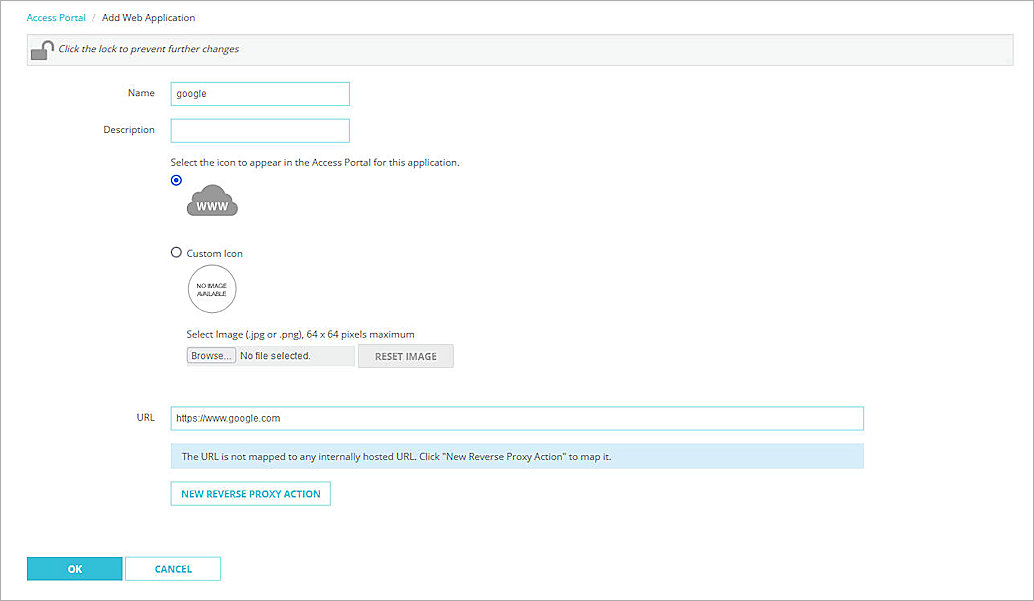
- Click OK.
- (Optional) Repeat Steps 4 - 8 to create additional web applications.
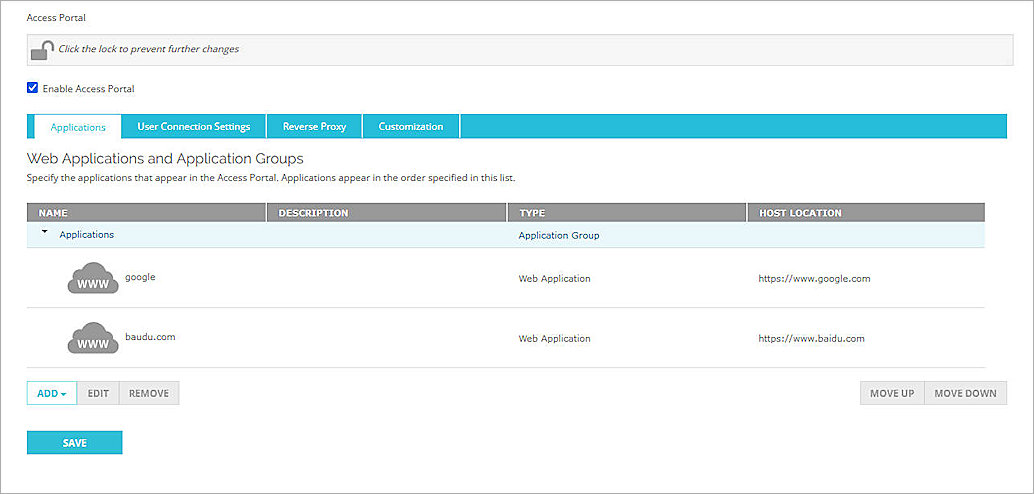
- Click Save.
Enable SAML Authentication Server
- Log in to WatchGuard Cloud.
- From the navigation menu, select Configure > AuthPoint. If you have a Service Provider account, you must select an account from Account Manager.
- Select Resources.
The Resources page appears. - Click Certificate.

- Next to the AuthPoint certificate you will associate with your resource, click
 and select Copy Metadata URL. We recommend that you choose the certificate with the latest expiration date. If you do not have a certificate, or if all of your certificates have expired, click Add Certificate and use the newly created certificate.
and select Copy Metadata URL. We recommend that you choose the certificate with the latest expiration date. If you do not have a certificate, or if all of your certificates have expired, click Add Certificate and use the newly created certificate.The AuthPoint metadata provides your resource, in this case, the Firebox Access Portal, with information necessary to identify AuthPoint as a trusted identity provider.

- Log in to Fireware Web UI (https://<your Firebox IP address>:8080).
- Select Authentication > Servers.
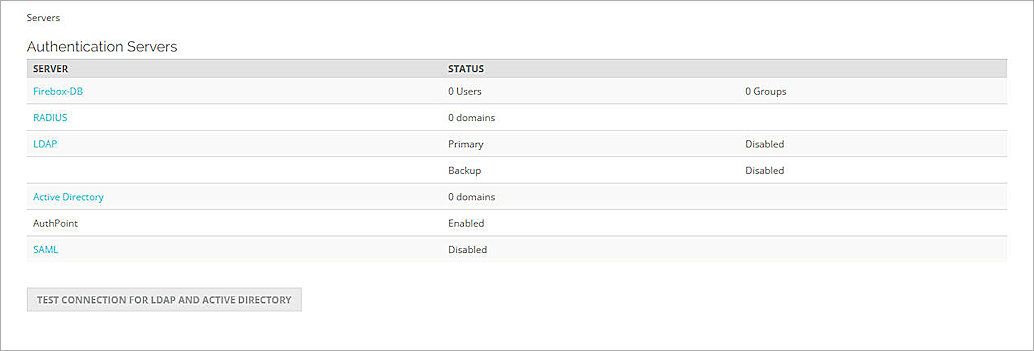
- Click SAML.
- Select the Enable SAML check box.
- In the IdP Name text box, type a name for the identity provider (AuthPoint). In our example, we type AuthPoint-SAML.
- In the Host Name text box, type the fully qualified domain name that resolves to the Firebox external interface.
- In the IdP Metadata URL text box, paste the URL you copied from the Certificates page in the AuthPoint web UI.
- Leave the default value for Group Attribute Name.
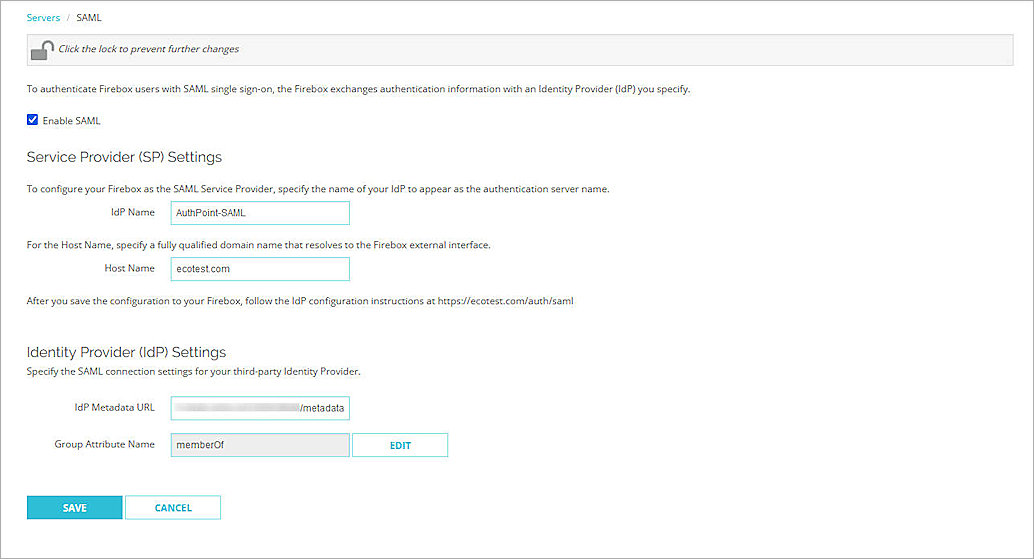
- Click Save.
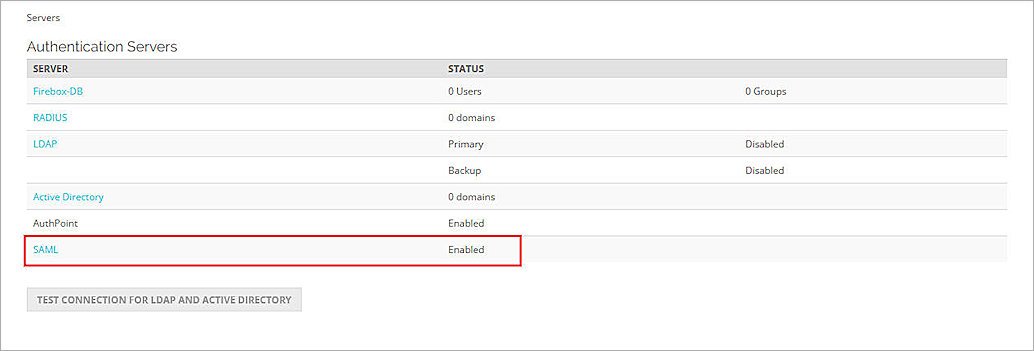
Define Users or Groups for the SAML Authentication Server
- Select Authentication > Users and Groups.
- Click Add.

- For Type, select Group.
There are two ways to manage your users. You can add a group that matches an AuthPoint user group, or you can add a user with a name that matches an AuthPoint user account. In our example, we add a group, but you can add a user instead.
- In the Name text box, type your group name. This group name must exactly match your AuthPoint group name. This is case–sensitive.
- From the Authentication Server drop-down menu, select AuthPoint-SAML (this is the IdP name we specified in the previous section).
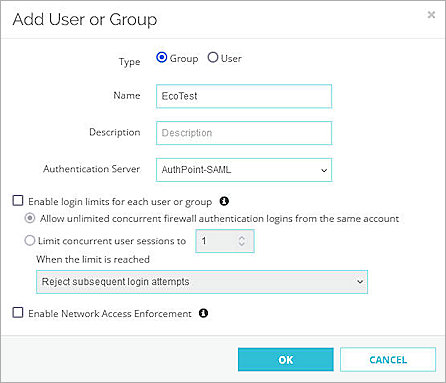
- Click OK.
- Click Save.
Access Portal User Connection Settings
- Select Subscription Services > Access Portal.
- Switch to the User Connection Settings tab.
- In the Authentication Servers section, from the Authentication server drop-down list, select AuthPoint-SAML (this is the IdP name we specified in the previous section).
- Click Add.
- (Optional) To give all users and groups permission to connect to all applications, In the User Access section, keep the default option All applications are available to all users and groups authenticated with Access Portal selected.
- To specify which users and groups can access which applications, in the User Access section, select the Specify the applications available to each user and group check box.
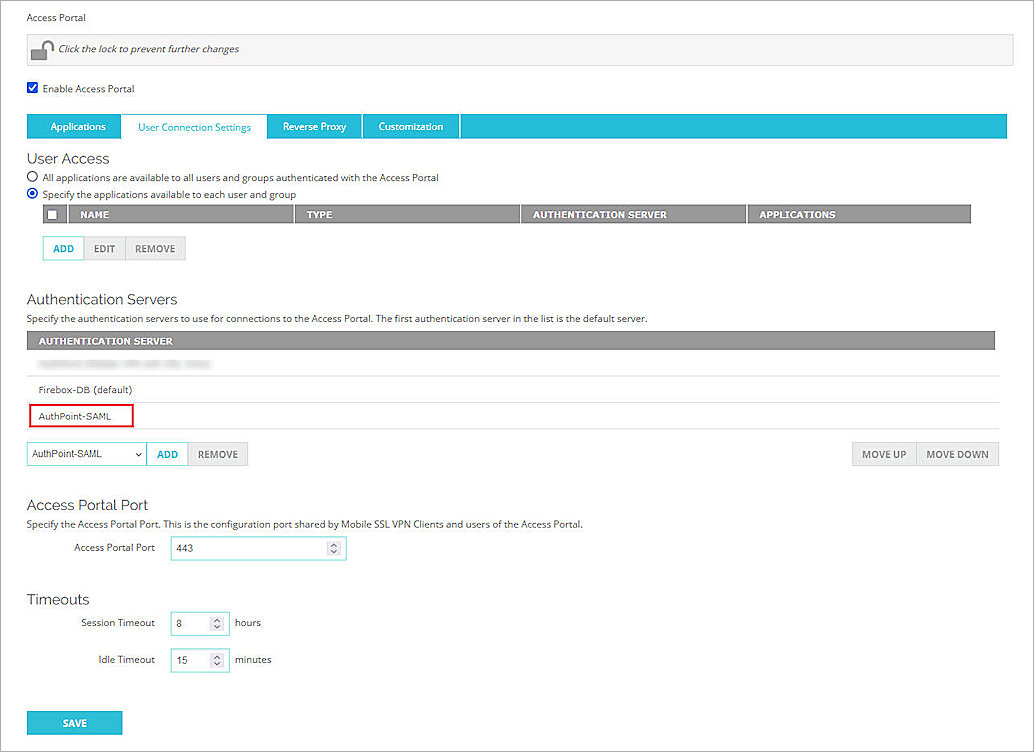
- Click Add.
- From the Authentication Server drop-down menu, select AuthPoint-SAML (this is the IdP name we specified in the previous section).
- From the Type drop-down menu, select Group.
There are two ways to manage your users. You can add a user that matches an AuthPoint user account, or you can add a group with a name that matches an AuthPoint group. In our example, we add a group, but you can add a user instead.
- In the Name text box, type the group name. The group name is the group you created in the previous section.
- Select which applications are available to this user or group.
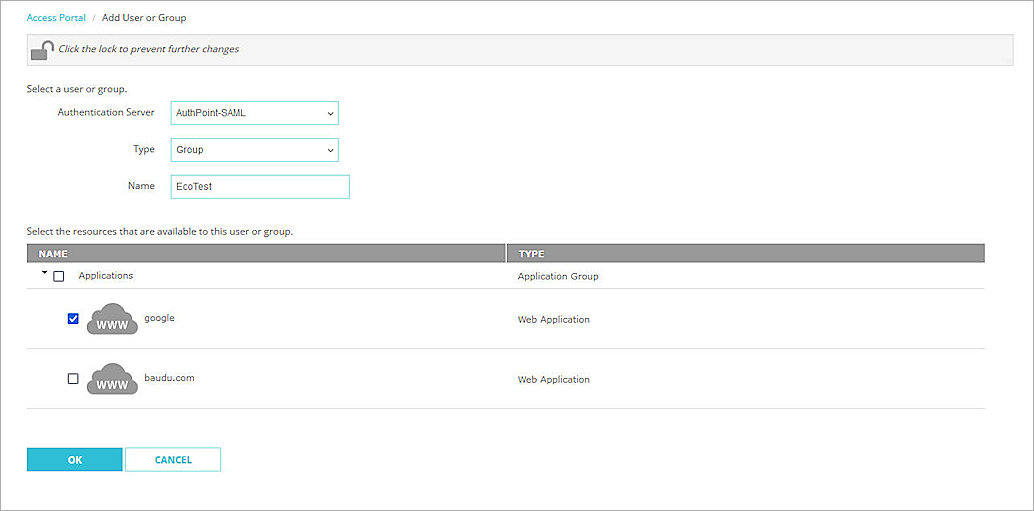
- Click OK.
- Click Save.
- Copy the SP Metadata URL, then click Done.
- Open a web browser and go to the SP Metadata URL (https://Host name or Firebox IP address/auth/saml). If you configure an Access Portal Port other than 443, you must navigate to https://Firebox interface IP address:custom port number/auth/saml.
The configuration instructions page appears.Several Firebox features use SSL/TLS for secure communication. For more information, see Shared Settings and Policy.
- Copy the SAML EntityID, Assertion Consumer Service (ACS) URL, and Single Logout Service (SLS) URL values from Option 2. These are used to configure the Access Portal resource in AuthPoint.
- SAML Entity ID – https://host name/auth/saml
- Assertion Consumer Service (ACS) URL – https://host name/auth/saml/acs
- Single Logout Service (SLS) URL – https://host name/auth/saml/sls
- Click Download Certificate.
The Access Portal certificate you download is valid for one year from the date you select the Enable SAML check box in the previous section. After you install the certificate, you can view the certificate expiry date in Fireware Web UI. When an Access Portal certificate expires, the Firebox generates a new certificate and you must upload the new certificate to AuthPoint.
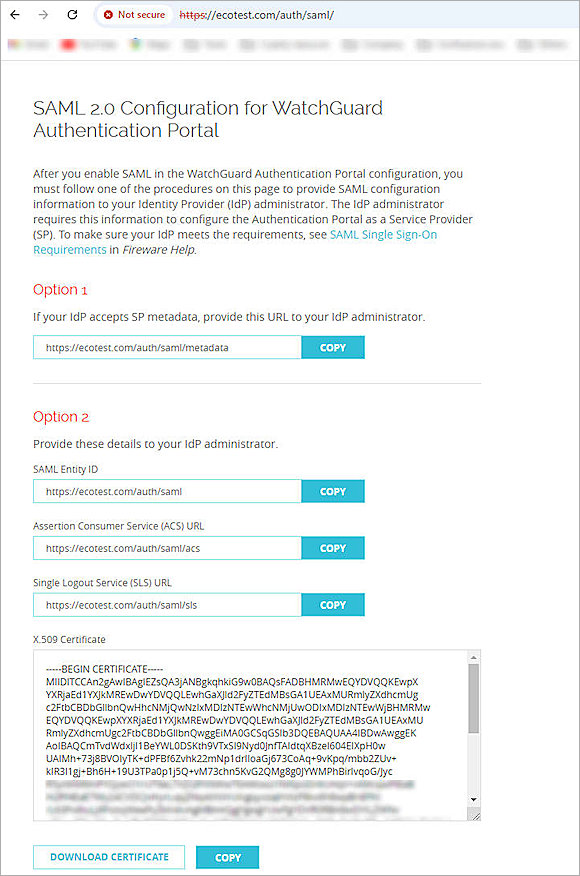
- Log in to WatchGuard Cloud.
- From the navigation menu, select Configure > AuthPoint. If you have a Service Provider account, you must select an account from Account Manager.
- Select Resources.
The Resources page appears. - Click Certificate.

- Next to the AuthPoint certificate you will associate with your resource, click
 and select Copy Metadata URL. We recommend that you choose the certificate with the latest expiration date. If you do not have a certificate, or if all of your certificates have expired, click Add Certificate and use the newly created certificate.
and select Copy Metadata URL. We recommend that you choose the certificate with the latest expiration date. If you do not have a certificate, or if all of your certificates have expired, click Add Certificate and use the newly created certificate.The AuthPoint metadata provides your resource, in this case the Firebox Access Portal, with information necessary to identify AuthPoint as a trusted identity provider.

- Log in to Fireware Web UI (https://your Firebox IP address:8080).
- Select Subscription Services > Access Portal.
- Select the Enable Access Portal check box.
- Select the SAML tab.
- Select the Enable SAML check box.
- In the IdP Name text box, type a name for the identity provider (AuthPoint). This shows as the server name for other Firebox settings. In our example, we type AuthPoint-SAML.
- In the Host Name text box, type the fully qualified domain name that resolves to the Firebox external interface.
- In the IdP Metadata URL text box, paste the URL you copied from the Certificates page in the AuthPoint web UI.
- Leave the default value for Group Attribute Name.

- Click Save.
- Select Authentication > Users and Groups.
- Click Add.

- For Type, select User.
There are two ways to manage your users. You can add a user that matches an AuthPoint user account, or you can add a group with a name that matches an AuthPoint group. In our example, we add a user, but you can add a group instead.
- In the Name text box, type your user name. This user name must exactly match your AuthPoint user name. This is case–sensitive.
- From the Authentication Server drop-down menu, select AuthPoint-SAML (this is the IdP name we specified in Step 11).

- Click OK.
- Click Save.
- Select Subscription Services > Access Portal.
- Switch to User Connection Settings tab.
- (Optional) To give all users and groups permission to connect to all applications, In the User Access section, keep the default option selected, All applications are available to all users and groups authenticated with Access Portal.
- To specify which users and groups can access which applications, in the User Access section, select the Specify the applications available to each user and group check box.
- Click Add.
- From the Authentication Server drop-down menu, select AuthPoint-SAML (this is the IdP name we specified in Step 11).
- From the Type drop-down menu, select User.
There are two ways to manage your users. You can add a user that matches an AuthPoint user account, or you can add a group with a name that matches an AuthPoint group. In our example, we add a user, but you can add a group instead.
- In the Name text box, type user name.
- Select which applications are available to this user or group. For detailed steps to add web applications and application groups to the Access Portal, see Configure the Access Portal.

- Click OK.
- Click Save.
- Open a web browser and go to https://Host name or Firebox IP address/auth/saml. If you configure an Access Portal Port other than 443, you must navigate to https://Firebox interface IP address:custom port number/auth/saml.
The configuration instructions page appears.Several Firebox features use SSL/TLS for secure communication. For more information, see Shared Settings and Policy.
- Copy the SAML EntityID, Assertion Consumer Service (ACS) URL, and Single Logout Service (SLS) URL values from Option 2. These are used to configure the Access Portal resource in AuthPoint.
- SAML Entity ID – https://host name/auth/saml
- Assertion Consumer Service (ACS) URL – https://host name/auth/saml/acs
- Single Logout Service (SLS) URL – https://host name/auth/saml/sls
- Click Download Certificate.
The Access Portal certificate you download is valid for one year from the date you select the Enable SAML check box in Step 10. After you install the certificate, you can view the certificate expiry date in Fireware Web UI. When an Access Portal certificate expires, the Firebox generates a new certificate and you must upload the new certificate to AuthPoint.

Configure AuthPoint
Before AuthPoint can receive authentication requests from the Firebox Access Portal, you must add a SAML resource in AuthPoint. You must also create an authentication policy for the Firebox Access Portal resource to determine which users can authenticate and log in to the Firebox Access Portal and which authentication methods they can use (Push, QR code, and OTP).
Add a SAML Resource in AuthPoint
From the AuthPoint management UI:
- From the navigation menu, select Resources.
Click Add Resource.
The Add Resource page opens.

- From the Type drop-down list, select SAML.
Additional fields appear.

- In the Name text box, type the resource name.
- From the Application Type drop-down list, select Firebox Access Portal.
- In the Service Provider Entity ID text box, paste the SAML EntityID value you copied in the Access Portal User Connection Settings section (https://your Host Name/auth/saml).
- In the Assertion Consumer Service text box, paste the Assertion Consumer Service (ACS) URL value you copied in the Access Portal User Connection Settings section (https://your Host Name/auth/saml/acs).
- From the User ID sent on redirection to service provider drop-down list, select User Name.
- In the Logout URL text box, paste the Single Logout Service (SLS) URL value you copied in the Access Portal User Connection Settings section (https://your Host Name/auth/saml/sls).
- From the Signature Method drop-down list, select SHA-256.
- For Certificate, click Select a file to import and upload the Access Portal certificate you downloaded in the Access Portal User Connection Settings section.
- Adjacent to the Certificate, select the Encryption enabled slider to enable encryption.
- From the AuthPoint Certificate drop-down list, select the AuthPoint certificate to associate with your resource. This must be the same certificate that you copied the metadata URL from in the Enable SAML Authentication Server section.
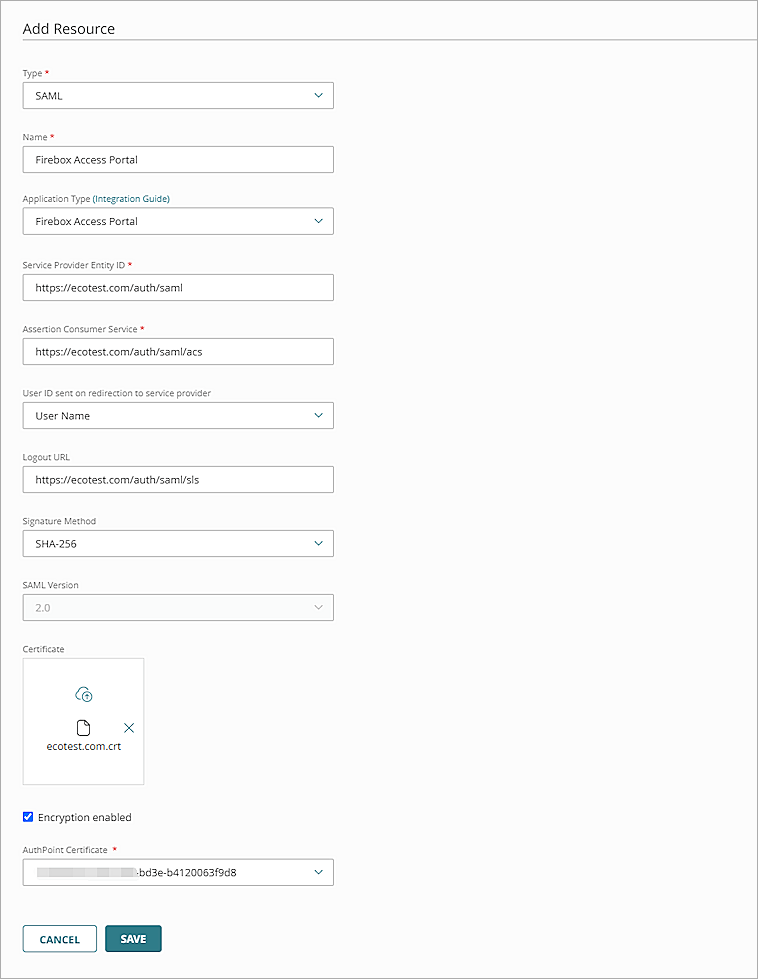
- Click Save.
Add a Group to AuthPoint
You must have at least one user group in AuthPoint. If you already have a group, you do not have to add another group.
To add a WatchGuard Cloud-hosted group to the WatchGuard Cloud Directory:
- Go to Configure > Directories and Domain Services.
- Click the WatchGuard Cloud Directory domain name. If you have not yet added the WatchGuard Cloud Directory, click Add Authentication Domain and select the WatchGuard Cloud Directory.
The New Group page appears.
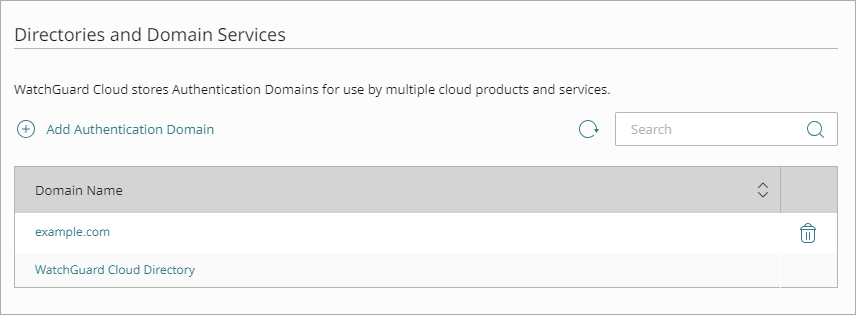
- In the Groups tab, click Add Group.
- In the Group Name text box, type a descriptive name for the group.
- (Optional) In the Description text box, type a description of the group.
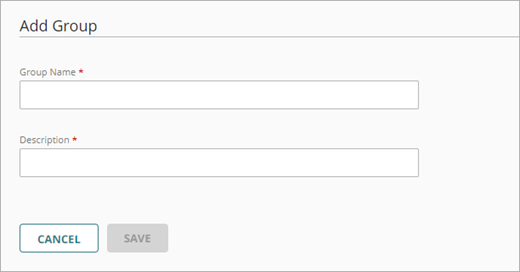
- Click Save.
Your group is added to the WatchGuard Cloud Directory and to AuthPoint.
Add an Authentication Policy to AuthPoint
Authentication policies specify which resources users can authenticate to and which authentication methods they can use (Push, QR code, and OTP).
You must have at least one authentication policy in AuthPoint that includes the Access Portal resource. If you already have authentication policies, you do not have to create a new authentication policy. You can add this resource to your existing authentication policies.
Users that do not have an authentication policy for a specific resource cannot authenticate to log in to that resource.
To configure an authentication policy:
- From the navigation menu, select Authentication Policies.
- Click Add Policy.

- Type a name for this policy.
- From the Select the Authentication Options drop-down list, select Authentication Options and select which authentication options users can choose from when they authenticate.
For SAML resources, if you select more than one authentication option, users must select one of the available options when they authenticate. For example, if you select OTP and Push, users can choose to type their OTP or approve a push to authenticate. You cannot require that they do both.

- Select which groups this policy applies to. You can select more than one group. To configure this policy to apply to all groups, select All Groups.
- Select the resource that you created in the previous section. If you want this policy to apply to additional resources, select each resource this policy applies to. To configure this policy to apply to all resources, select All Resources.

-
(Optional) If you have configured policy objects such as a Network Location, select which policy objects apply to this policy. When you add a policy object to a policy, the policy only applies to user authentications that are the same as the conditions of the policy objects. For example, if you add a Network Location to a policy, the policy only applies to user authentications that come from that Network Location. Users who only have a policy that includes a Network Location do not get access to the resource when they authenticate outside of that Network Location (because they do not have a policy that applies, not because authentication is denied).
If you configure policy objects, we recommend that you create a second policy for the same groups and resources without the policy objects. The policy with the policy objects should have a higher priority.

- Click Save.
Your policy is created and added to the end of the policy list.When you create a new policy, we recommend that you review the order of your policies. AuthPoint always adds new policies to the end of the policy list.

Add Users to AuthPoint
Before you assign users to a group, you must add the users to AuthPoint. There are two ways to add AuthPoint user accounts:
- Sync users from an external user database
- Add WatchGuard Cloud-hosted AuthPoint users
Each user must be a member of a group. You must add at least one group before you can add users to AuthPoint.
To import users from Active Directory, Microsoft Entra ID, or an LDAP database, you must add an external identity in the AuthPoint management UI. External identities connect to user databases to get user account information and validate passwords.
- To sync users from Active Directory or an LDAP database, you must add an LDAP external identity
- To sync users from Microsoft Entra ID, you must add a Microsoft Entra ID external identity
When you sync users from an external user database, you can sync any number of users and they are all added to AuthPoint at one time. Users synced from an external user database use the password defined for their user account as their AuthPoint password.
To learn how to sync users, go to Sync Users from Active Directory or LDAP and Sync Users from Azure Active Directory.
You create WatchGuard Cloud-hosted users and groups from the WatchGuard Cloud Directory in WatchGuard Cloud. Directories and Domain Services is where you add shared authentication domains for WatchGuard Cloud devices and services, such as AuthPoint.
Users that you add to the WatchGuard Cloud Directory are automatically added to AuthPoint as well.
You add local AuthPoint users form Directories and Domain Services. You manage the users in AuthPoint on the Users page.
When you add WatchGuard Cloud-hosted AuthPoint users, you choose whether the user is an MFA user or a non-MFA user.
- MFA users are user accounts that will use AuthPoint multi-factor authentication to authenticate. This is not related to the AuthPoint Multi-Factor Authentication license type.
- Non-MFA users are users that will only ever authenticate with a password, such as a service account user. Non-MFA users do not consume an AuthPoint user license and cannot authenticate to resources that require MFA. They can only authenticate to protected resources if the non-MFA user account has a password only authentication policy for that resource.
After you add a user, you can edit the user account if you need to change their account type. When you change a user account from MFA to non-MFA, AuthPoint deletes the tokens and password vault (if applicable) that belong to the user. This action cannot be undone.
Unlike users synced from an external user database, WatchGuard Cloud-hosted AuthPoint users define and manage their own AuthPoint password. When you add a WatchGuard Cloud-hosted user account, the user receives an email that prompts them to set their password.
To learn how to add WatchGuard Cloud-hosted AuthPoint user accounts to the WatchGuard Cloud Directory, go to Add Local Users to an Authentication Domain.
Test the Integration
To test the integration of AuthPoint and the configuration of your Access Portal, you can authenticate with a mobile token on your mobile device. You can choose any method (one-time password, QR code, or push).
In this example, we show the push authentication method (users receive a push notification in the mobile app that they must approve to authenticate).
- In a web browser, go to the Access Portal URL (https://Host Name of Firebox SAML Authentication Server).

- Select AuthPoint-SAML.
- Type your email address or AuthPoint user name. Click Next.
- If required, in the Password text box, type your password.
- Click Send Push.
- Approve the authentication request that is sent to your mobile device.
You are logged in to the Access Portal.
